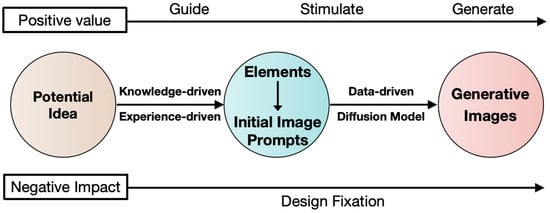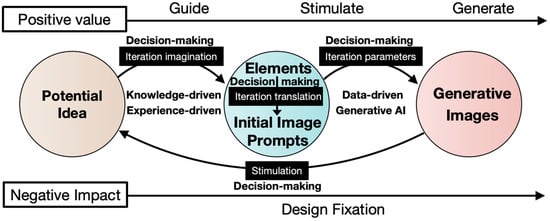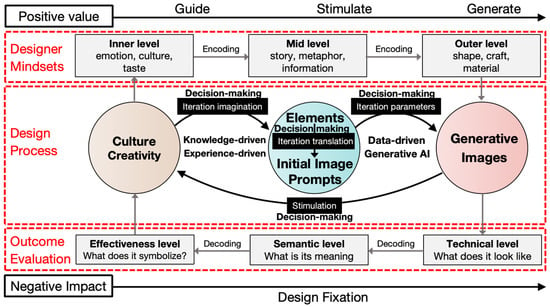You're using an outdated browser. Please upgrade to a modern browser for the best experience.
Please note this is a comparison between Version 1 by Yanru Lyu and Version 2 by Catherine Yang.
The current proliferation of artificial intelligence (AI) is prominently shaping the design industry. Generative AI, such as text-to-image and image-to-image models, has gained widespread use, notably for its efficiency and quality improvements. Leveraging AI image generators has shifted the designer’s focus from technical tasks to strategic decisions related to visual appeal, cognitive engagement, and emotional resonance. Furthermore, the challenges inherent in human–AI collaboration have been revealed, stemming from communication difficulties and the risk of fixating on specific details to stylistic constraints.
- generative AI
- imagination
- cultural translation
- jewelry design
1. Introduction
The process of design is characterized by its intricate and elusive nature, but creativity is manifested in the whole process, especially the early stages of design. Ideation in design, alternatively, creative idea generation, always plays a vital role in the early stages of production design. With the accelerating development of generative artificial intelligence (AI) algorithms in recent years, its application has achieved extraordinary outcomes in different fields, including the creative design [1]. To date, designers can harness and interact with various text-to-image or image-to-image Al models (e.g., Midjourney [2], Stable Diffusion [3], OpenAI’s DALL-E 2 [4], and Deep Dream Generator [5]), which could facilitate in augmenting creativity and stimulating visual imagination and ideation [6][7][6,7].
Jewelry, being a highly personalized and swiftly iterative product category, necessitates a multitude of creative concepts to flourish, thus rendering it a pivotal domain suitable for the implementation of AI. It is essential to recognize that this specific product category transcends mere adornment and extends to encapsulate emotions and attitudes [8]. As Hong Kong jewelry designer Dickson Yewn stated, jewelry is “the new way to interpret a culture” [9]. Social progress and cultural development have an obvious influence on the forms, functions, and meanings of jewelry designs [10]. Cultural sustainability indicates the capacity to maintain and perpetuate cultural beliefs, practices, and heritage, while also ensuring the continuation of culture in the future [11]. Within the realm of design, cultural value can be embedded in products through creative design, which involves integrating cultural elements into new artistic forms to pass on multiple cultures to consumers and activate the cultural value [12][13][12,13]. However, the potential of human–AI collaboration in setting cultural translation as a design goal has not yet received wide attention.
2. Computer-Aided Design
Technology is of great importance in the design process, providing designers with a series of computer-aided design (CAD) tools, including graphic software, 3D modeling software, and digital rendering platforms. The CAD for concept generation can be categorized into three types according to their potential roles in the human–computer collaborative relationship: guide, stimulation, and generation [14]. The methods to guide are instructively involved in the generation of design concepts, which aim to provide design rules or guidelines for the activities of the designers, such as team-based brainstorming and mind mapping. Stimulation refers to knowledge-based methods and visual stimuli like images and sketches, which can influence design performance [15]. Generation denotes that designers can use various software to draw sketches, pictures, or three-dimensional prototypes, which is a crucial step in shaping creativity and can help designers further communicate and evaluate ideas [16]. With the rapid advancement in generative AI technology in recent years, more intelligent new design tools and functions are emerging, which then integrate a series of generative AI models such as generative pre-trained transformers (GPTs), generative deep models (GDMs), and generative adversarial networks (GANs) [17][18][17,18]. These have received increasing interest from the design community, including the field of jewelry design. Generative AI tools represented by Midjourney [2] and Stable Diffusion [3] can help designers quickly complete designs with high accuracy and repeatability. They use prompts as inputs combined with image generation algorithms with large language models to facilitate text-guided image generation. The basic logic is to combine or merge a large number of ideas to produce much stronger ones [6]. Additionally, increasing studies concentrate on the challenges and opportunities of human–AI collaboration in diverse contexts [19][20][21][19,20,21]. Based on some empirical studies, the AI agent assists designers in diversifying their solutions to fulfill the design objectives and presents great potential to guide more explorative design strategies [22][23][22,23]. However, in terms of generative AI, there is a great limitation that they are currently only capable of learning and generating spatially visualized representations of design concepts based on training data sets, which are mainly helpful for detail design and may cause design fixation if applied in earlier stages [16]. Although CAD has been widely used in jewelry design to improve efficiency, the current system focuses more on quick modeling (e.g., Rhinoceros 3D, Blender, ZBrush). There were few tools to assist in generating conceptual design before the emergence of generative AI. An earlier AI-design practice named “the chair project”, took generative adversarial neural networks (GANs) as automatisms to stimulate the imagination of human designers [24]. Limited by the washout problem of GANs, generative images still need designers to handle most visualization tasks and to add details based on design principles and creativity. The latest applications of AI are to generate visual images from natural language descriptions and initial image guides, which can create thousands of higher-quality images with minimal effort [6]. The use of new technology forces designers to broaden their understanding of the design process and adapt their methods, ultimately leading to the potential generation of innovative products [25][26][25,26]. A novel form of production is based on past models but only comes into being in response to individual demand. Therefore, the advantages and design limitations brought by AI technology make human–computer interaction more complex. While there is methodological readiness for designing with CAD, the nuances of human–AI collaboration need to be further explored from the perspective of the workflow in generative AI-augmented design creativity (Figure 12). The mapping from potential ideas to specific elements is closely associated with the experience and knowledge of the creator [21]. After the translation from inputted elements such as images or text description, the AI model handles the next stage to decoding, latent diffusion, and encoding in the pixel space to generate numerous new related images. Both training data sets and parameter settings influence the outputs. Moreover, it may bring positive value, such as guidance, stimulation, and generation, while also having an impact on design fixation.
Figure 12.
The workflow in generative AI-augmented design creativity.
3. Activities in Human–AI Collaboration
In Cross’s earlier studies, he found that seemingly, the only ”positive” effect of CAD was to speed up the design process, while reducing the person-power required in the team [27]. However, he believed human–machine interaction would efficiently produce design solutions better than that which a human or a machine could produce alone. To find the answer to whether the machine can design, it is necessary to analyze the design activities of people [28]. Unlike conventional liner technology that achieves one outcome based on one action, AI poses challenges to the creative process and workflow, characterized by its learning pattern and random generation [29]. Computer design research informs us concerning designers’ thinking [28]. Facing infinite and limitless sources of information, requirements, wants and needs, limitations, and opportunities, the designer has to make all kinds of decisions and judgments [30]. Numerous studies on design practice have indicated that designers who can handle complex design situations successfully use design thinking and activities [31][32][31,32]. The utilization of emerging technologies stimulates designers to expand their understanding of the design process and alter their design methods, which in turn has potentially generated new products [26]. Moreover, incorporating AI into products, services, and systems is complex, requiring the attention of the design discipline, and the initial answers might be hidden in the design cognition [33]. The design process involves a continuous series of decision-making activities that collectively shape a final outcome [34]. Design as research is an approach that combines the principles of design and research methodologies to address complex problems and generate new knowledge. It involves using design processes and methods to investigate, explore, and understand problems, as well as to propose and test potential solutions [35][36][35,36]. Designing is intimately tied to new technologies that generate a complex set of decision points for designers. The changes, problems, and solutions of traditional design influenced by technology can be explored from the design process [26][37][26,37]. In collaboration with generative AI tools, the activities, such as what prompts should be inputs and which images can be chosen to further update, are usually driven by decisions. Then, decision-making is also influenced by experience, knowledge, and preferences. Visual stimulation can assist the perception and interpretation of more ephemeral phenomena by color, texture, form, images, and status [38]. Iteration is considered an integral part of design activity that may be classified as the diagnostic and transformative process [39][40][39,40]. Adams and Atman empirically explored the iteration behavior in the design process, recognizing that compared to beginners in design, senior designers iterate more times and more effectively [41]. Focusing on the impact of AI on design iteration, Zhou et al. conducted a graphic design experiment and results indicate AI augmentation increases the frequency of cognitive activities during iteration [23]. Actually, the activities of human–AI collaboration encompass a complex cyclical process, as shown in Figure 23.
Figure 23.
The workflow of generative AI-aided design creativity.
4. Cultural Translation in Jewelry Design
Currently, more attention is given to the role and importance of culture in sustainable development. Cultural features are considered unique features that can be embedded in products to achieve sustainable cultural spread and value transformation [42][43][42,43]. Therefore, it is crucial to confirm the methods for integrating cultural elements into creative product design. Based on previous research, the factors that affect cultural and creative product design include aesthetics, creativity, practicality, and commercial value, which are taken into consideration [44][45][44,45]. Lee [46] introduced the term “cultural variable”, which means to profile cultural characteristics and identify the key design attributes, such as functional, aesthetic, and symbolic ones. There, cultural objects can be incorporated into cultural design. Lin [43] identified three design features: inner-level (e.g., stories, emotions, and cultural features), mid-level (e.g., function, operational concerns, usability, and safety), and outer-level (e.g., color, texture, form, decoration, surface pattern, line quality, and detail). To bridge the implicit layer of culture and an explicit layer of design characteristics, a series of culture-embedded product design models were proposed and developed from the perspective of communication [43][47][48][43,47,48], which divided the design and perceptual process of the product into the technical level, semantic level, and effectiveness level. The technical level requires attracting the users through cultural features through their senses; the semantic level focuses on precisely transmitting cultural information; and the effectiveness level concerns the emotional connection and reflection. Traditional jewelry design is time-consuming and labor-intensive. It requires a high level of drafting skills. Furthermore, the unique jewelry design can be created by harnessing different pattern combinations in varying proportions, but it leads to a very tedious design process [24]. While several designers have embraced traditional Chinese elements such as dragons, the phoenix, bamboo, and Chinese characters into their products, they occasionally do not apply or combine them properly, making them become less meaningful [9]. On the contrary, appropriate combinations of elements can accurately convey cultural information. Designers pass the new concept into the jewelry through the material, color, craft technique, etc., which causes the wearer’s spiritual resonance [49]. From the coding perspective of jewelry design, the external features of design include shape, craftsmanship, and materials. The combination of these features also carries cultural metaphors, ultimately conveying a sense of ritual and pleasure [9][50][9,50], as displayed in Figure 34.
Figure 34.
The research framework for the impact of generative AI on cultural translation in jewelry design.
